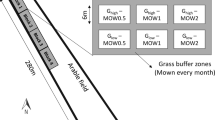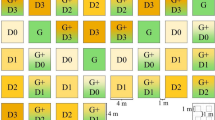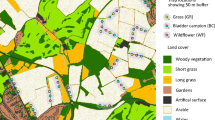Abstract
Grasshoppers are important components of grassland invertebrate communities, particularly as nutrient recyclers and as prey for many bird species. Sown margin strips are key features of agri-environmental schemes in European agricultural landscapes and have been shown to benefit grasshoppers depending on the initial sown seed mixture. Understanding the mechanisms by which the sown mixture impacts grasshoppers in sown margin strips is the aim of our study. Here, we investigated plant–grasshopper interactions in sown margin strips and the respective effects of plant identity and diversity on grasshoppers. We surveyed plants and grasshoppers in 44 sown margin strips located in Western France which were initially established with three sowing mixtures dominated, respectively, by alfalfa, Festuca rubra and Lolium perenne and Festuca arundinacea. Grasshopper species contrasted in their response to plant diversity and to the abundance of sown and non-sown plant species. Some grasshopper species were positively correlated with the abundance of grass and especially of a single sown plant species, F. rubra. In contrast, other grasshopper species benefited from high plant diversity likely due to their high degree of polyphagy. At the community level, these contrasted responses were translated into a positive linear relationship between grass cover and grasshopper abundance and into a quadratic relationship between plant diversity and grasshopper diversity or abundance. Since plant identity and diversity are driven by the initial sown mixture, our study suggests that by optimizing the seed mixture, it is possible to manage grasshopper diversity or abundance in sown margin strips.


Similar content being viewed by others
References
Asteraki EJ, Hart BJ, Ings TC, Manly WJ (2004) Factors influencing the plant and invertebrate diversity of arable field margins. Agric Ecosyst Environ 102:219–231
Badenhausser I, Cordeau S (2012) Sown grass strip—a stable habitat for grasshoppers (Orthoptera: Acrididae) in dynamic agricultural landscapes. Agric Ecosyst Environ 159:105–111
Badenhausser I, Amouroux P, Lerin J, Bretagnolle V (2009) Acridid (Orthoptera: Acrididae) abundance in Western European Grasslands: sampling methodology and temporal fluctuations. J Appl Entomol 133:720–732
Baldi A, Kisbenedek T (1997) Orthopteran assemblages as indicators of grassland naturalness in Hungary. Agric Ecosyst Environ 66:121–129
Barker AM (2004) Insect as food for farmland birds—Is there a problem? In: Van Emden H, Rothschild M (eds) Insects and bird interactions. Intercept Ltd, Hampshire, pp 37–50
Belovsky GE, Slade JB (2000) Insect herbivory accelerates nutrient cycling and increases plant production. Proc Natl Acad Sci USA 97:14412–14417
Bernays EA, Chapman RF (1970) Experiments to determine the basis of food selection by Chorthippus parallelus (Zetterstedt) (Orthoptera: Acrididae) in the field. J Anim Ecol 39:761–776
Bretagnolle V, Villers A, Denonfoux L, Cornulier T, Inchausti P, Badenhausser I (2011) Rapid recovery of a depleted population of Little Bustards Tetrax tetrax following provision of alfalfa through an agri-environment scheme. Ibis 153:4–13
Burnham KP, Anderson DR (2002) Model selection and multimodel inference: a practical information-theoretic approach. Springer, New York
Cole LJ, Brocklehurst S, Elston DA, McCracken DI (2012) Riparian field margins: can’t hey enhance the functional structure of ground beetle (Coleoptera: Carabidae) assemblages in intensively managed grassland landscapes? J Appl Ecol 49:1384–1395
Cordeau S, Reboud X, Chauvel B (2010) The relative importance of farmer practices and landscape structure on the weed flora of sown grass strips. Agric Ecosyst Environ 139:595–602
Delattre T, Pichancourt JB, Burel F, Kindlmann P (2010) Grassy field margins as potential corridors for butterflies in agricultural landscapes: a simulation study. Ecol Model 221:370–377
Deraison H, Badenhausser I, Börger L, Gross N (2015) Herbivore effect traits and their impact on plant community biomass: an experimental test using grasshoppers. Funct Ecol 29:650–661
Development Core Team R (2013) R: a language and environment for statistical computing. Foundation for Statistical Computing, Vienna
Di Giulio M, Edwards PJ, Meister E (2001) Enhancing insect diversity in agricultural grasslands: the roles of management and landscape structure. J Appl Ecol 38:310–319
Dinnage R, Cadotte MW, Haddad NM, Crutsinger GM, Tilman D (2012) Diversity of plant evolutionary lineages promotes arthropod diversity. Ecol Lett 15:1308–1317
Ernoult A, Vialatte A, Butet A, Michel N, Rantier Y, Jambon O, Burel F (2013) Grassy strips in their landscape context, their role as new habitat for biodiversity. Agric Ecosyst Environ 166:15–27
Fielding DJ, Brusven MA (1993) Grasshopper (Orthoptera, Acrididae) community composition and ecological disturbance on Southern Idaho rangeland. Env Entomol 22:71–81
Frampton GK, Dorne JLCM (2007) The effects on terrestrial invertebrates of reducing pesticide inputs in arable crop edges: a meta-analysis. J Appl Ecol 44:362–373
Gardiner T, Hassall M (2009) Does microclimate affect grasshopper populations after cutting of hay in improved grassland? J Insect Conserv 13:97–102
Gardiner T, Pye M, Field R, Hill J (2002) The influence of sward height and vegetation composition in determining the habitat preferences of three Chorthippus species (Orthoptera: Acrididae) in Chelmsford, Essex, UK. J Ortho Res 11:207–213
Gotelli NJ (2000) Null model analysis of species co-occurrence patterns. Ecology 81:2606–2621
Hudewenz A, Klein AM, Scherber C, Stanke L, Tscharntke T, Vogel A, Weigelt A, Weisser WW, Ebeling A (2012) Herbivore and pollinator responses to grassland management intensity along experimental changes in plant species richness. Biol Conserv 150:42–52
Huston MA (1997) Hidden treatments in ecological experiments: re-evaluating the ecosystem function of biodiversity. Oecologia 110:449–460
Journal Officiel de la république Française (2005) Arrêté du 12 janvier 2005 pris pour l’application des articles R. 615-10 et R. 615-12 du code rural et relatif aux règles de couvert environnemental et d’assolement, NOR : AGRP0500059A, 19 Janvier 2005
Kati V, Zografou K, Tzirkalli E, Chitos T, Willemse L (2012) Butterfly and grasshopper diversity patterns in humid Mediterranean grasslands: the roles of disturbance and environmental factors. J Insect Conserv 16:807–818
Losey JE, Vaughan M (2006) The economic value of ecological services provided by insects. Bioscience 56:311–323
Maire V, Gross N, Pontes LDS, Picon-Cochard C, Soussana JF (2009) Trade-off between root nitrogen acquisition and shoot nitrogen utilization across 13 co-occurring pasture grass species. Funct Ecol 23:668–679
Maire V, Gross N, Börger L, Proulx R, Wirth C, Pontes LDS, Soussana JF, Louault F (2012) Habitat filtering and niche differentiation jointly explain species relative abundance within grassland communities along fertility and disturbance gradients. New Phytol 196:497–509
Marshall EJP, West TM, Kleijn D (2006) Impacts of an agri-environment field margin prescription on the flora and fauna of arable farmland in different landscapes. Agric Ecosyst Environ 113:36–44
Meek B, Loxton D, Sparks T, Pywell R, Picket H, Nowakowski M (2002) The effect of arable field margin composition on invertebrate biodiversity. Biol Conserv 106:259–271
Meiss H, Mediene S, Waldhardt R, Caneill J, Bretagnolle V, Reboud X, Munier-Jolain N (2010) Perennial lucerne affects weed community trajectories in grain crop rotations. Weed Res 50:331–340
Otway SJ, Hector A, Lawton JH (2005) Resource dilution effects on specialist insect herbivores in a grassland biodiversity experiment. J Anim Ecol 74:234–240
Pinheiro JC, Bates DM (2000) Mixed-effects models in S and S-PLUS. Springer, New York
Robinson RA, Sutherland WJ (2002) Post-war changes in arable farming and biodiversity in Great Britain. J Appl Ecol 39:157–176
Rzanny M, Voigt W (2012) Complexity of multitrophic interactions in a grassland ecosystem depends on plant species diversity. J Anim Ecol 81:614–627
Schaffers AP, Raemakers IP, Sykora KV, Ter Braak CJF (2008) Arthropod assemblages are best predicted by plant species composition. Ecology 89:782–794
Scherber C, Mwangi PN, Temperton VM, Roscher C, Schumacher J, Schmid B, Weisser WW (2006) Effects of plant diversity on invertebrate herbivory in experimental grassland. Oecologia 147:489–500
Scherber C, Heimann J, Kohler G, Mitschunas N, Weisser WW (2010) Functional identity versus species richness: herbivory resistance in plant communities. Oecologia 163:707–717
Schmitz OJ (1998) Direct and indirect effects of predation and predation risk in old-field interaction webs. Am Nat 151:327–342
Torrusio S, Cigliano MM, de Wysiecki ML (2002) Grasshopper (Orthoptera: Acridoidea) and plant community relationships in the Argentine pampas. J Biogeogr 29:221–229
Tracy BF, Renne IJ, Gerrish J, Sanderson MA (2004) Effects of plant diversity on invasion of weed species in experimental pasture communities. Basic Appl Ecol 5:543–550
Tscharntke T, Brandl R (2004) Plant-insect interactions in fragmented landscapes. Annu Rev Entomol 49:405–430
Turchin P (2003) Complex population dynamics: a theoretical/empirical synthesis. Princeton University Press, New Jersey
Unsicker SB, Oswald A, Kohler G, Weisser WW (2008) Complementarity effects through dietary mixing enhance the performance of a generalist insect herbivore. Oecologia 156:313–324
Vickery JA, Tallowin JR, Feber RE, Asteraki EJ, Atkinson PW, Fuller RJ, Brown VK (2001) The management of lowland neutral grasslands in Britain: effects of agricultural practices on birds and their food resources. J Appl Ecol 38:647–664
Woodcock BA, Potts SG, Tscheulin T, Pilgrim E, Ramsey AJ, Harrison-Cripps J, Brown VK, Tallowin JRB (2009) Responses of invertebrate trophic level, feeding guild and body size to the management of improved grassland field margins. J Appl Ecol 46:920–929
Woodcock BA, Savage J, Bullock JM, Nowakowski M, Orr R, Tallowin JRB, Piwell RF (2013) Enhancing beetle and spider communities in agricultural grasslands: the roles of seed addition and habitat management. Agric Ecosyst Environ 167:79–85
Acknowledgments
We thank M. Girardello for his useful comments on the manuscript and Eduardo Tedesco and Alexander Coles for English revisions. We thank the farmers of the study site for allowing us to perform surveys on their sown margin strips. This study was funded by the ANR-ECOGER and by ANR-BIODIVERSITE.
Author information
Authors and Affiliations
Corresponding author
Additional information
Handling Editor: Heikki Hokkanen.
Appendices
Appendix 1: Co-occurrences analysis between sown and weed plant species
See Fig. 3.
Eleven weed species dominated weed communities: Elytrigia repens L. (ELREP), Arrhenatherum elatius L. (ARREL), Cirsium arvense L. (CIRAR), Concolvulus arvensis L. (CONAR), Daucus carota L. (DAUCA), Picris echioides L. (PICEC), Picris hieracioides L. (PICHI), Plantago lanceolata L. (PLALA), Sonchus asper L. (SONAS), Taraxacum officinale Weber (TAROF), Verbena officinalis L. (VEROF). Co-occurrence between sown and weed species was observed for D. glomerata with E. repens, D. carota, P. hieracioides, for F. arundinacea with C. arvense and S. asper and for M. sativa with T. officinale (Figs. 1, 3). At the opposite end, P. echioides was not present in sown margin strips where F. pratense was abundant (Figs. 1, 3). The same trend was observed for T. officinale which was not observed when F. rubra or L. perenne dominated in sown margin strips and for V. officinale when L. perenne was abundant (Figs. 1, 3).
Appendix 2: Effect of sown seed mixture on plant community
See Fig. 4.
Predicted mean (±SE) of grass cover index (a) and legume cover index (b), plant Shannon index (c), plant species richness in 2009 (d), in sown strips established using three types of sown mixture [GFa: mixture dominated by F. arundinacea (n = 40), GFrLp: mixture dominated by F. rubra and L. perenne (n = 40), GL: mixture with equal proportion of legumes and grasses (n = 8)]. Bars in white are sown plant species, and bars in gray are weed species
Total grass cover index was higher when margin strips were sown with mixtures containing F. rubra and L. perenne (GFrLp) or dominated by F. arundinacea (GFa) than with grass–legume mixture (GL) (Fig. 4a) (sown mixture effect: P < 0.001). Legume almost had no cover in sown margin strips sown with GFa, compared to those sown with GFrLp and to GL mixture (Fig. 4b) (sown mixture effect: P < 0.001). Forb cover index did not differ between margin strips sown with the three types of mixtures (sown mixture effect: P = 0.11). GL mixture resulted in higher plant diversity compared to the other mixtures (Fig. 4c) (sown mixture effect: P = 0.04). Plant species richness in 2009 was the highest in sown margin strips established with the GL mixture (Fig. 4d) (year effect: P < 0.001; sown mixture effect: P = 0.13; interaction term: P = 0.004).
Appendix 3
See Table 4.
Rights and permissions
About this article
Cite this article
Badenhausser, I., Gross, N., Cordeau, S. et al. Enhancing grasshopper (Orthoptera: Acrididae) communities in sown margin strips: the role of plant diversity and identity. Arthropod-Plant Interactions 9, 333–346 (2015). https://doi.org/10.1007/s11829-015-9376-x
Received:
Accepted:
Published:
Issue Date:
DOI: https://doi.org/10.1007/s11829-015-9376-x






